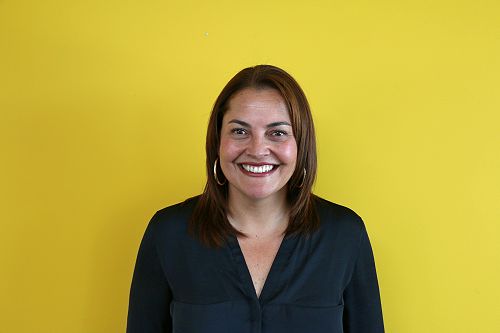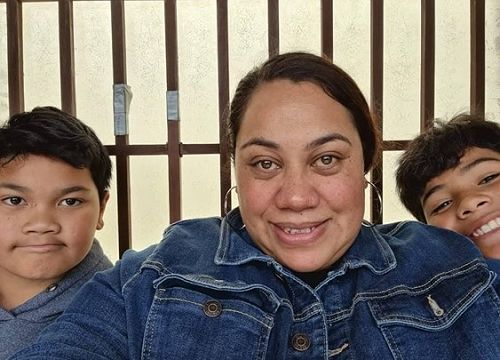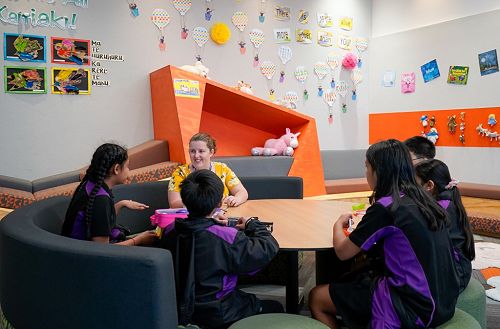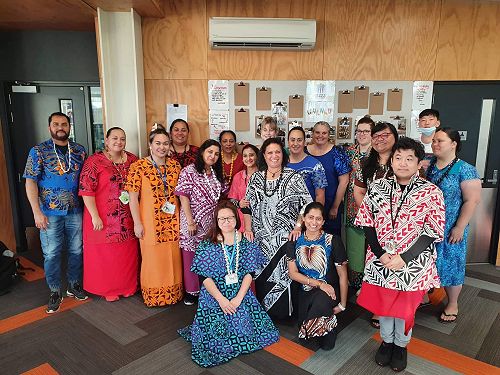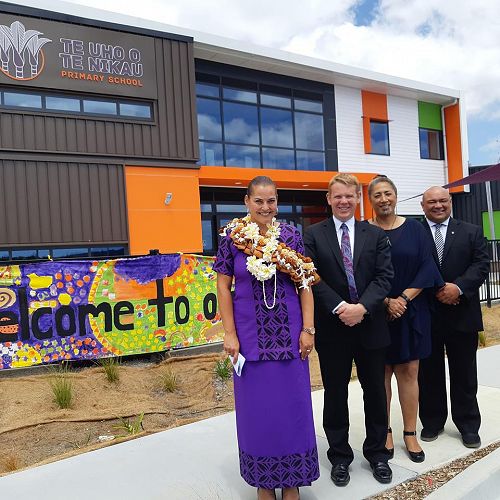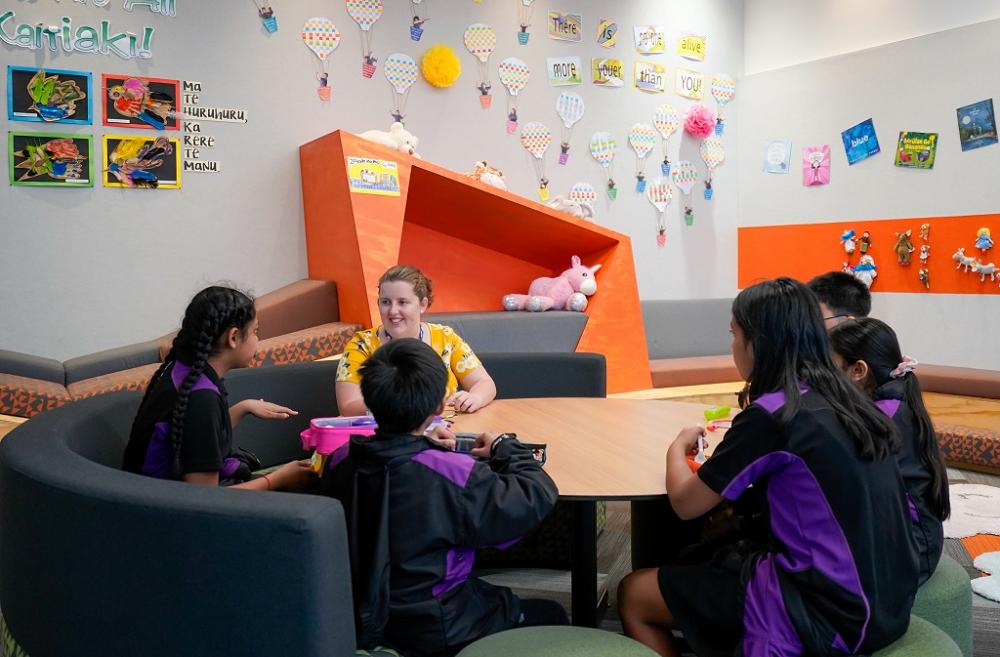
Te Uho o te Nikau - building an authentic curriculum while building a learning community
Mel Bland - foundation tumuaki, and Bev Aerenga - foundation deputy principal at Te Uho o te Nikau School in Flat Bush, Auckland share some key elements of their journey that have informed their local curriculum design since 2018.
Our community
Flat Bush is a new town rapidly developing on the border of Botany. Our area will house an anticipated population of 40,000 by 2025. The Ormiston Town Centre will form the retail hub for this newly established residential area with construction under way. It will include retail stores, restaurants, a gym, movie theatres, a library, an aquatic centre, and a range of public open spaces that will connect to the neighbouring Barry Curtis Park. Flat Bush is best described as a work in progress. Houses are going up everywhere as this former area of farmland is rapidly transformed into a residential suburb. Long-time lifestyle and small farm property owners are gradually selling up, as their land is developed for housing. Many of the newcomers are immigrants from Asia, Europe and Africa, as well as those from other parts of New Zealand. As one of Auckland’s newest housing areas, Flat Bush complies with the aims of the new Auckland Unitary Plan which calls for more medium and high density housing. As a result, the area is taking on an exciting but very different look from the traditional quarter acre pavlova paradise of old New Zealand. Flat Bush is also one of New Zealand’s most comprehensively planned urban developments, which means it is not just about housing. Nearby is the huge 94 hectare Barry Curtis Park - a park with a difference, and well worth a trip via the distinctive bridge on Ormiston Road that runs through the middle of the park.

Mana Whenua
The school maintains a valuable partnership with the local iwi, Ngāi Tai ki Tāmaki, and local history has influenced aspects of the school’s unique name, establishment and environment. The development of the ‘story’ of the school is strong. One example of this is that kaupapa Māori is very well integrated into the school’s day-to-day operations. Children are already familiar with many aspects of this such as the use of te reo Māori, celebrations - e.g. Matariki, tikanga - digging, preparing for and cooking hāngī, the Mihi Whakatau held for new children and their whānau, and so on. Te reo Māori is also used in the school context by both staff and children as a matter of course – for example, the inclusion of some vocabulary in day-to-day interactions – e.g mahi, whānau, whakarongo mai, and the school’s ‘place names’ – e.g. the names of the learning kainga. The school has also strived to ensure that children know the history of the local area and the meanings of place names – e.g. Te Irirangi Drive. This level of not simply integration, but instead of normalisation, is still mostly unusual in a number of mainstream schools. Thirdly, the history of the local whenua is known, valued and spoken about. In addition, these aspects of the school’s kaupapa are being continually expanded and embedded in everyday operations and our localised curriculum. The school’s links with history, language and cultural practices places the school in a very strong position for the introduction of the New Zealand Histories Curriculum at the beginning of 2023. Our reading of this document assures the leadership team that Te Uho o te Nikau School already demonstrates many of the suggested principles and practices. The school is well placed to introduce this new curriculum and to continue to develop the school’s ‘story’ using many of the ideas, while many school are ‘starting from scratch’ in regard to this curriculum.
Our Name
Thoughts of a cultural concept for the bridges connecting the carpark to the school, a Nikau design plan, was offered by the local iwi Ngāi Tai ki Tāmaki through Zaelene Maxwell- Butler, who was an Establishment Board trustee. This then informed the narrative from which a new name grew.
- Uho means (noun) heart (of a tree), pith of a tree, umbilical cord, core. Phonetic pronunciation – “Uhaw”
- Nikau – we refer to the rākau (tree) that once stood plentiful in the landscape now gone, struggling to survive in the growth, the expansion of Auckland.

Initial thoughts lead to the purpose of the tree and its structure. Nikau provided nourishment and shelter for the once many manu (birds), the analogy being the berries are the teachings and the manu are the tamariki (children). See our chosen whakatauki:
Ko te manu e kai ana i te miro nōna te ngahere. Ko te manu e kai ana i te mātauranga nōna te ao
The bird that partakes of the miro berry reigns in the forest. The bird that partakes in the power of knowledge has access to the World.
Diversity and Inclusion
The huge diversity and cultural make up of our school and staff is unique and yet everyone is represented. We have 33 countries represented by our tamariki and their whānau. Our staff is made up of 14 ethnicities – Hong Kong Chinese, Taiwanese, Samoan, NZ European, Māori, Cook Island Māori, Filipino, Korean, Fijian, Indian, Niuean, Kiribati, English, and Indo-Fijian. There are over 35 languages spoken in our community! We celebrate our diversity everyday and also in the following ways, driven by and organised by our parents with some staff support:
Chinese New Year, Vietnamese New Year [Tet], Korean New Year, Waitangi Day, Ramadan, Eid, Choul Chnam Thmey [Khmer New Year], NZ Sign Language Week, Samoan Language Week, Philippines Independence, Matariki, Kiribati Language Week, Cook Islands Language Week,Tonga Language Week, Te Wiki o te Reo Māori, African Heritage Day, NZ Chinese Language Week, Niue Language Week, Diwali, Fiji Language Week, Pink Shirt Day and more ...
At the same time, whilst celebrating cultures, all of our neurodiverse children are part of all celebrations. They are included to their comfort level. We have 15 different neurodiverse and high behavioural needs at our school. We are also experiencing a lot of what other schools are experiencing, with a large amount of kids with different needs than what we have seen before, due to Covid lockdowns. Our neurodiverse children are loved, accepted and catered for. They each have their own pathway to success mapped out in very small steps. We are very lucky that Mt Richmond is our satellite school. They are an awesome resource for us in terms of advice, and sometimes even their state of the art facility and learning resources.

Commitment to Biculturalism
Despite our diverse and largely migrant community, Te Uho o te Nikau hold a strong commitment to biculturalism. 13 learners identify as Māori [approx. 5%] with solid connections between the school and their whānau. We are proud that the iwi we connect to is Ngāi Tai ki Tāmaki (Ngāi Tai) who are the original inhabitants and iwi of Tāmaki Makaurau. The iwi is based in Maraetai, Te Waitematā and Tikapa Moana, and exercises mana whenua and mana moana interests across Auckland and the Hauraki Gulf. Our main marae is Umupuia at Maraetai. Ngāi Tai ki Tāmaki were represented on our establishment board and gifted us our beautiful school name. They have been instrumental in guiding us in honouring Te Tiriti o Waitangi.
At Te Uho o te Nikau Primary School it is vital that we recognise and discuss the importance of biculturalism with our learners and their families. Our children are the future of Aotearoa NZ, and we cannot educate children from a monocultural, monolingual perspective and position. Māori culture and language are nurtured and protected at our school – there is a strong support and emphasis on te reo Māori and tikanga Māori interwoven throughout the curriculum and ethos of the school. What you might see, hear and feel at our school?
Greetings in Māori, Whakatauki around the school, Wayfinding in te reo, Children singing waiata, Kainga wide karakia at the start of an event, before eating or during whanau time, The use of te reo integrated during the day, Mihi Whakatau, Kapahaka group, Significant celebrations, e.g. Matariki, Te Wiki o te reo Māori, Hangi, Stories about our area, A special wairua.
Our values
Our school values underpin all we do – learning, positive behaviour for learning, the Hauora curriculum, a rewards system for tamariki, community engagement, and shaping our hui with whānau.
Our values were developed and defined throughout our establishment year. The values of growth, ownership, trust, membership and security guide our curriculum design, pedagogy and the way we ‘roll’ at Te Uho o te Nikau Primary School.
- Growth - We believe that students and staff learn authentically when they integrate experience, imagination, information and application. Na te waewae i kimi (Obtain by seeking). Learning is a creative journey that doesn’t look the same for everyone. We grow when we try new things, make mistakes and aspire to be the best version of ourselves.
- Ownership - We believe that students and staff who think for themselves enhance our learning environment. Kei ou ringaringa te ao (The world is yours). We know that we can overcome challenges and take responsibility for our own journey.
- Trust - We believe that reciprocal trust is the heart of our learning culture. He waka eke noa (We’re all on one waka). I’ve got your back and you’ve got mine and together we will thrive.
- Membership - We believe that all our school community can learn in different ways. Nā tō rourou, nā taku rourou ka ora ai te iwi (With your basket and my basket, the people will thrive). Belonging to our community means accepting everyone and sharing ourselves.
- Security - We believe in relationships that challenge, inspire and give security. Ma te huruhuru, ka rere te manu (Adorn the bird with feathers so it can fly). Our school is a safe place where we are comfortable to be ourselves and tackle challenges.
Our teaching and learning
While the eight learning areas are presented as distinct, this does not limit the way we structure the learning experiences offered to our learners. At Te Uho o te Nikau Primary School, all learning makes use of the natural connections that exist between learning areas. We believe our staff and students learn effectively when they integrate experience, imagination, information and application. Our Programme of Inquiry honours the New Zealand Curriculum and supports the integration of all learning areas in different ways. Each term particular strands of a learning area may be emphasised. Our Inquiry programme is driven to definitively offer the appropriate mix of teacher guided and co-created, as well as self regulated, authentic learning opportunities. Our process of inquiry guides ākonga and kaiako in their learning.


Literacy and maths are priorities with a special emphasis on oral language, which is extra important given our large number of English language learners. We also offer a wide range of extra curricular activities, some of which are learner led. Read more about our learning here: https://www.tenikau.school.nz/our-learning/ where you can learn more about some of the unique features of our curriculum: Te Haututu, Te Uho Beat, Roots of Empathy, Student Leaders, Our Dog in School and Mai Kana.
Our Graduate Profile
Graduate profiles are one way that a school can communicate a shared understanding of what a future-oriented learner looks like. They describe skills, knowledge, and attitudes that students will need to develop in order to participate in a range of life contexts beyond school. As our community grew, our graduate profile grew with it. We aligned our school values and our beliefs around learner dispositions. Under each school value we co-wrote three goals. We then created three indicators for success next to each goal. We currently collect real-time evidence of these skills, knowledge and attitudes on HERO. We call these the Graduate Profile learning posts. We are also in the process of designing a name for this profile - something that captures the potential and light we see in each of our students. Please see our Graduate Profile here: https://www.tenikau.school.nz/graduate-profile/
#everythingisadraft
The biggest hashtag trending at our school is #everythingisadraft. This hashtag is even on top of a lot of our documents! We try things out, if it's blatantly not working we give it time, and if our trial and error period doesn’t give us the outcomes we are aiming for, we change. We have come to know that everything is a draft because every new idea needs teething space. Once we figure out what teething problems our ideas may have operationally, we review and sharpen up what would work better. So, getting the appropriate mix of teacher guided, co-created and self regulated authentic learning opportunities is still a draft.
About our contributors:
Mel feels incredibly privileged to be the Foundation Principal at Te Uho o te Nikau Primary School, alongside the challenge as a first time Principal. Some might call her crazy but her mentor calls her passionate. With a school doubling in size each year in a new area of Tamaki Makaurau, Mel's initial focus has been on growing a sustainable school community, systems, processes and culture - no pressure! Having grown her own leadership experience within the NZ and international school environments she has worked in, Mel treasures the richly diverse community she leads and the endless opportunities for learning focused partnerships. Mel is proud and humbled to lead her diverse tamariki, kaiako and community in learning and relishes the connections she makes everyday in their special place.Bev is the Foundation Deputy Principal of Pastoral Care/SENCo at Te Uho o te Nikau Primary School as part of the #dreamteam but Bev's favourite title is Mum. She has two school-aged boys, the older one is known as “ the one I pushed out” and the younger one is my whangai child, so I call him the “one I pulled in". Bev shared with us, "Truth be told as a Cook Islander, it’s pretty standard to claim everyone’s kids as your own. My passion for serving children started way before I started teaching. In my formative years I spent time travelling to entertain youth and kids. I have taught at both the primary and intermediate level as a syndicate leader and senior teacher. More recently, working at a new school in Ormiston really changed my practice! I was a confident teacher before I got there - but collaboratively teaching with three other great teachers in the same room developed my leadership and pedagogical kete! I also became very curious about new schools".
Read more about Te Nikau here: https://www.tenikau.school.nz/
Gallery
